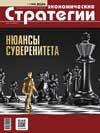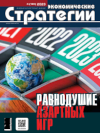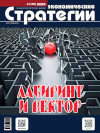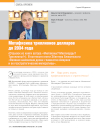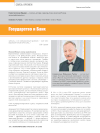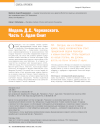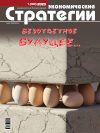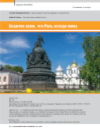D.I. Mendeleev — Political Economist
Activities of the State Defence Council to Strengthen the Defence Capability of the Russian Empire at the Beginning of the XXth Century
DOI: 10.33917/es-1.193.2024.126-131
The author examines the main activities of the State Defenсe Council (SDC) of the Russian Empire to ensure the defenсe potential at the beginning of the XXth century, in particular elaboration of a general plan for the state defence in accordance with requirements of that time and development of the provisions of the state military doctrine, which was accompanied by a major scientific discussion. Based on a large number of archival documents and materials, the stages of decision-making by the SDC and implementation of major measures to strengthen the defence capability of the empire are revealed. The author traces the ways of solving a very difficult task – strengthening military potential of the state in difficult conditions on the eve of the First World War.
References:
1. Stoletie Voennogo ministerstva [Centenary of the War Ministry]. Saint Petersburg, 1911, vol. 3, otd. 6, pp. 300, 301.
2. Rossiyskiy gosudarstvennyy voenno-istoricheskiy arkhiv (RGVIA) [The Russian State Military Historical Archive (hereinafter RGVIA)]. F. 830, Op. 1, D. 11.
3. Kuzin V.V. Sovet Gosudarstvennoy Oborony v Rossii (1905–1909 gg.): Diss. … kand. ist. nauk [Council of State Defense in Russia (1905–1909): Diss. Candidate of… ist. sciences]. Moscow, 1950.
4. Russkaya voennaya mysl’: konets XIX — nachalo XX v. [Russian Military Thought: End of XIX — beginning XX century]. Moscow, Nauka, 1982.
5. Russkaya voenno-teoreticheskaya mysl’ XIX — nachala XX v. [Russian Military Theoretical Thought of the 19th century — beginning XX century]. Moscow, Voenizdat, 1960.
6. Strokov A.A. Vooruzhennye sily i voennoe iskusstvo v Pervoy mirovoy voyne [Armed Forces and Military Art in the First World War]. Moscow, Voenizdat, 1974, pp. 87–117.
7. Kozlov S. Voennaya nauka i voennye doktriny [Military Science and Military Doctrines]. Voenno-istoricheskiy zhurnal, 1964, no II, pp. 72.
8. Neznamov A.A. Sovremennaya voyna. Deystviya polevoy armii [Modern War. Field Army Actions]. Saint Petersburg, 1911.
9. Strokov A.A. Istoriya voennogo iskusstva [Armed Forces and Military Art]. In 5 vol. Moscow, Voenizdat, 1955, 1965, 1967 (vol. 1–3); Saint Petersburg, Poligon, 1994 (vol. 4, 5).
10. Zayonchkovskiy A. Edinstvo voennoy doktriny (opasnosti i uvlecheniya) [Unity of Military Doctrine (Danger and Passion)]. Russkiy invalid, 1911.
11. Frunze M.V. Izbrannye proizvedeniya [Selected Works]. Moscow, Voenizdat, 1984.
12. Zhurnal (no 10) Osoboy podgotovitel’noy komissii pri SGO [Journal (No. 10) of the Special Preparatory Commission for the CSD]. RGVIA, F. 2000, Op. 1, D. 346.
13. RGVIA [RGVIA]. F. 830, Op. 1, D. 168.
14. RGVIA [RGVIA]. F. 2000, Op. 1, D. 153.
Great Empire. Historic Symphony No. 1
How the Fuhrer and Others Like Him Forced out Soviet Oil from the German Market
DOI: 10.33917/es-3.189.2023.118-131
Based on diplomatic documents, a detailed picture of driving oil product suppliers – the Soviet companies, Derop and Derunaft – out from the German market during 1933 is restored. Soviet intelligence materials prove that one of the inspirers of this process can be considered the major Anglo-Dutch oil tycoon Henry Deterding, who in the course of the alleged “crusade” against the USSR, among other things hoped to seize the Caucasian oil fields.
References:
1. Morozov S.V. K voprosu o roli neftyanogo faktora v evropeiskikh mezhdunarodnykh otnosheniyakh v techenie 1933–1935 gg.: VII chteniya, posvyashchennye pamyati R.L. Yavorskogo: Materialy Vserossiiskoi nauchnoi konferentsii s mezhdunarodnym uchastiem[On the question of the role of the oil factor in European international relations during 1933–1935: VII readings dedicated to the memory of R.L. Yavorsky. Materials of the All-Russian Scientific Conference with International Participation]. Novokuznetsk, RIO KuzGPA, 2011, 288 p.
2. Morozov S.V. Khronika vytesneniya sovetskoi nefti s germanskogo rynka v techenie 1933 g.: IX chteniya, posvyashchennye pamyati R.L. Yavorskogo: Materialy Vserossiiskoi (s mezhdunarodnym uchastiem) nauchnoi konferentsii[Chronicle of the displacement of Soviet oil from the German market during 1933: IX readings dedicated to the memory of R.L. Yavorsky. Materials of the All-Russian Scientific Conference with International Participation]. Novokuznetsk, RIO KuzGPA, 2013, 320 p.
3. Gekht E.V. Neft’ v politike Germanii (1933–1943) [Oil in German Politics (1933–1943)]. Avtoref. dis. … kand. ist. nauk. Ekaterinburg, 2007. 22 s.
4. Medlicott W.N. The Economic Blockade. Vol. 1. L., Longmans, Green and Co., 1952, 756 p.
5. Birkenfeld W. Der synthetische Treibstoff 1933–1945: Ein Beitrag zur nationalsozialistischen Wirtschafts- und Rüstungspolitik. Göttingen, Berlin, Frankfurt, Musterschmidt-Verlag, 1964, 278 p.
6. Teichert E. Autarkie und Grossraumwirtschaft in Deutschland 1930–1939: Aussenwirtschaftpolitische Konzeptionen zwischen Wirtschaftskriese und Zwseitem Weltkrieg. München, Oldenburg, 1984, 390 p.
7. Mejcher H. Die Politik und das Öl im Nahen Osten. Bd. 2: Die Teilung der Welt 1938–1950. Stuttgart, Klett-Gotta, 1990, 490 p.
8. Karlsch R., Stockes G.R. Faktor Öl. Die Mineralölwirtschaft in Deutschland 1859–1974. München, C.H. Beck Verlag, 2003, 460 p.
9. Kockel T. Deutsche Ölpolitik 1928–1938. Berlin, Akademie Verlag GmbH, 2005, 393 p.
10. Klein B.H. Germany’s Economic Preparations for War. Cambridge Massachusets, Harvard University press, 1959, 272 p.
11. Friedwald E.M. Oil and the War. L., Heineman, 1941, 88 p.
12. Pеarton M. Oil and the Romanian State. Oxford, Clarendon press, 1971, 361 p.
13. Sesyuli R. IG Farbenindustri[IG Farbenindustri]. Moscow, Gos. izd-vo in-i lit-ry, 1948. 244 s.
14. Bruks M. Neft’ i vneshnyaya politika[Oil and foreign policy]. Moscow, Izd-vo in-i lit-ry, 1949, 173 p.
Biological Crimes — Organic Nature of Nazism
DOI: 10.33917/es-3.189.2023.108-117
Definition of biological weapons is given, periodization of its creation and use is presented. The author draws an analogy between the war crimes aimed at destruction of civilians and war prisoners during the Second W orld War and at the present time. The connection of Nazism and neo-Nazism with biological crimes against humanit y is revealed.
References:
1. Zaitsev A.I. Ostorozhno: biologicheskaya voina [Caution: Biological Warfare]. Zashchita i bezopasnost’, 2020, no 3, pp. 24.
2. Velikaya Otechestvennaya voina 1941–1945 gg.: Dokumenty i materialy, vol. Х. Osvobozhdenie Krasnoi Armiei [The Great Patriotic War of 1941–1945: Documents and materials. T. H. Liberation by the Red Army]. Pod obshch. red. S.K. Shoigu. Moscow, 2017, 463 p.
3. Kontslagerya — zhizn’ v adu [Concentration Camps – Living in Hell]. Alye parusa, 2012, 15 maya, available at: https://nsportal.ru/ap/library/drugoe/2012/05/11/kontslagerya-zhizn-v-adu.
4. Palivoda S. Tragediya i podvig Bukhenval’da [Tragedy and the feat of Buchenwald]. L’vov, Svit, 1990, 285 p.
5. Vakhsman N. Istoriya natsistskikh kontslagerei [History of Nazi Concentration Camps]. Moscow, Tsentrpoligraf, 2019, 877 p.
Biologicheskoe oruzhie i biologicheskii terrorizm. Zashchita ot biologicheskogo oruzhiya voisk, naseleniya i etapov meditsinskoi evakuatsii [Biological Weapons and Biological Terrorism. Protection of Troops, Population and Medical Evacuation Stages Against Biological Weapons]. MED-REF.BY, available
at: https://med-ref.by/referati_mes/2729-referat-biologicheskoe-oruzhie-i-biologicheskiy-terrorizm-zaschita-ot-biologicheskogo-oruzhiya-voysk-naseleniyai-etapov-medicinskoy-evakuacii.html.
V Rossii zayavili o nachale biologicheskoi voiny [In Russia the beginning of Biological Warfare was Announced]. Dzen, 2020, 2 maya, available at: https://dzen.ru/a/Xq1TC2jzBlqJIiU6.
Geneticheskoe oruzhie [Genetic Weapons]. Akademiya Alekseeva, available at: https://aleksejev.ru/free_portfolio/1252/22393/?p=3.
Konventsiya o zapreshchenii razrabotki, proizvodstva i nakopleniya zapasov bakteriologicheskogo (biologicheskogo) i toksinnogo oruzhiya i ob ikh unichtozhenii [Convention on the Prohibition of the Development, Production and Stockpiling of Bacteriological (Biological) and Toxin Weapons and on
their Destruction]. Ofitsial’nyi sait OON, 1971, 16 dekabrya, available at: https://www.un.org/ru/documents/decl_conv/conventions/bacweap.shtml.
Konovalov P.P., Arsent’ev O.V., Buyanov A.L., Nizovtseva S.A., Maslyakov V.V. Primenenie biologicheskogo oruzhiya: istoriya i sovremennost’ [Use of Biological Weapons: the History and the Present]. Sovremennye problemy nauki i obrazovaniya, 2014, no 6, p. 1170.
Supotnitskii M.V. Zhivaya smert’: chto takoe biologicheskoe oruzhie [Living Death: what is a Biological Weapon]. Populyarnaya mekhanika, 2018, no 1, pp. 74–77.
Tan U. Khimicheskoe i bakteriologicheskoe (biologicheskoe) oruzhie i posledstviya ego vozmozhnogo primeneniya: Doklad na XXIV sessii General’noi Assamblei OON [Chemical and Bacteriological (Biological) Weapons and the Consequences of Their Possible Use: Report to the XXIV Session of the UN
Trillion Dollar Metaphysics until 2034
State and Bank
D.S. Chernavsky Model. Part 1. Adam Smith
DOI: 10.33917/es-2.188.2023.98-107
This article considers the system of views of D.S. Chernavsky on the economics of Adam Smith. It turns out that the famous English economist was a convinced statesman. In his famous work “On the Nature and Causes of the Wealth of Nations” he substantiates the need for price regulation, limiting interest rates and also considers transnational corporations the greatest evil in the economy (he calls them “large joint-stock companies”). A. Smith convincingly proves that money is a tool for generating income, but not the income of society itself.
The appendix to the article presents a mathematical model of the loan capital functioning, developed by the author under the guidance of D.S. Chernavsky.
References:
1. Shcherbakov A.V. Mifologiya Adama Smita (o chem na samom dele kniga “Issledovanie o prirode i prichinakh bogatstva narodov”) [Mythology of Adam Smith (what “An Inquiry into the Nature and Causes of the Wealth of Nations” is Actually about)]. Moscow, Grifon, 2016, 64 p.
2. Smit A. Issledovanie o prirode i prichinakh bogatstva narodov [An Inquiry into the Nature and Causes of the Wealth of Nations]. Moscow, Eksmo, 2007.
3. Marks K., Engel’s F. Manifest Kommunisticheskoi partii: Sochineniya [The “Manifesto of the Communist Party”: Essays]. Vol. 4. Moscow, Gosudarstvennoe izdatel’stvo politicheskoi literatury, 1955, 616 p.
4. Chernavskii D.S., Shcherbakov A.V. Mir bez dollara i FRS [World without the Dollar and the Fed]. Institut sotsial’no-ekonomicheskogo prognozirovaniya im. D.I. Mendeleeva, available at: http://mendeleev-center.ru/articles/article-0006.html.
5. Polnyi spisok vsekh voennykh prestuplenii SShA [Complete list of all US war Crimes]. Oko planet, 2011, 16 iyunya, available at: http://oko-planet.su/politik/politiklist/71678-polnyy-spisok-vseh-voennyh-prestupleniy-soedinennyh-shtatov-ameriki.html.
6. Sorok protsentov mirovogo bogatstva kontroliruyut 147 transnatsional’nykh korporatsii [Forty Percent of the World’s Wealth is Controlled by 147 Multinational Corporations]. Gumanitarnyi portal, 2011, 24 oktyabrya, available at: https://gtmarket.ru/news/corporate/2011/10/24/3685.
Tell Everyone that Rus’ is Always Alive
DOI: 10.33917/es-1.187.2023.110-119
The fate of Russia is a hard military work, wars with various defensive and offensive goals. The people at war, their heroism and tragedy – this is the leitmotif of this article. History of the Fatherland is essentially a military chronicle of Russian statehood. It is important to feel the inextricable thread of times, the full depth and richness of the Fatherland’s heroic traditions, dating back to ancient times.





